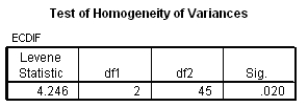Multiple Choice
An HR manager was looking at the effects of an employee involvement scheme on commitment levels of the organization's staff. Three groups were used: no scheme applied, experiencing the scheme and post scheme (a group who had been subjected to the scheme 6 months before) . The change in commitment over the time that the scheme was recorded is the dependent variable (although bear in mind that only the treatment group actually got any treatment during this time) . The SPSS output is below.


Based on this output what should the researcher conclude?
A) The employee involvement scheme groups did not have a significant effect on any change in commitment levels, F(2, 26.44) = 4.35
B) The employee involvement scheme groups had a significant effect on the change in commitment levels, F(2, 35.10) = 5.1.
C) The employee involvement scheme groups had a significant effect on the change in commitment levels, F(2, 45) = 5.11.
D) The employee involvement scheme groups did not have a significant effect on the change in commitment levels, F(2, 45) = 5.11.
Correct Answer:

Verified
Correct Answer:
Verified
Q6: What is the definition of 'mean square'?<br>A)
Q7: Do coffee products from China, India or
Q8: If the critical region for a hypothesis
Q9: Consider this table of customer net promoter
Q10: The F-ratio of 15.3 in the above
Q11: A training consultant wanted to see the
Q12: Using the same data, post hoc tests
Q13: A follow-up experiment to better understand net
Q15: When variances across groups are unequal, which
Q16: In a simple analysis of variance problem,